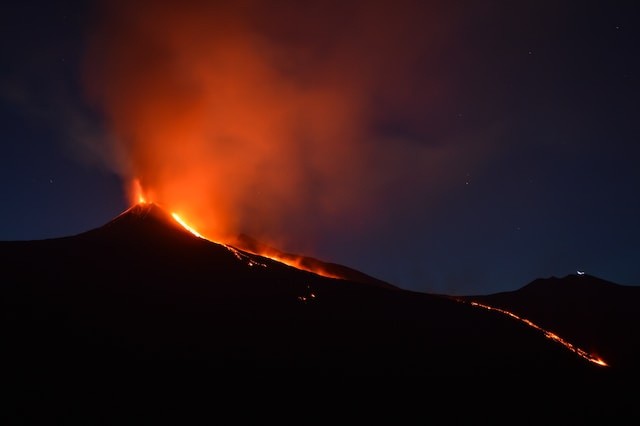On Sunday, August 13, Mount Etna erupted overnight, spewing lava and ash into the sky.
The eruption and the volcanic fallout forced the Catania International Airport, one of Sicily's main airports, to suspend all flights until Tuesday morning, August 15.
The airport closure caused disruptions and inconveniences for many travelers, especially during the peak of the summer holiday season and a public holiday in Italy.
The mayor of Catania also issued a temporary ban on the use of motorcycles and bicycles in the city, as many streets were covered in ash and posed a risk of accidents.
What caused the Mount Etna eruption?

Mount Etna is a stratovolcano, which means it is composed of layers of lava, ash, and rocks that have accumulated over time.
It is located above a subduction zone, where the African plate slides under the Eurasian plate. This creates pressure and heat that melt the rocks and produce magma. The magma rises to the surface through cracks and vents in the crust, causing eruptions.
The latest eruption of Mount Etna was signaled last week when it emitted gas rings, which are circular puffs of gas that are propelled into the air by the pressure inside the volcano.
These incredibly unusual occurrences take place when gas bubbles are forced through a small opening in the volcano, which rotates the edges of the puff of gas, giving it the appearance of a ring.
The eruption evolved into a lava fountain, which is a jet of lava that shoots up from an open vent. The lava fountain produced a volcanic cloud that dispersed in a southerly direction, creating a fallout of ash in the southern sector of the volcano and beyond.
The ash plume reached a height of about 10 kilometers (six miles) above sea level.
Also Read: Future Volcanic Eruption Imminent as Magma Chamber Grows Under Mediterranean Volcano [Study]
Mount Etna eruption affect the Catania airport and the local community
The volcanic cloud from Mount Etna posed a hazard for air traffic, as it can damage aircraft engines and reduce visibility.
Therefore, the Catania International Airport, known as Catania-Fontanarossa Airport, had to close its operations until 8 p.m. local time on Monday.
The airport is located about 16 kilometers (10 miles) southwest of Mount Etna, making it vulnerable to volcanic ash.
The airport closure affected many flights that were scheduled to arrive or depart from Catania, including those from destinations such as Malta, France, Austria, and other Italian regions.
Some flights were canceled, delayed, or diverted to other airports in Sicily. This caused frustration and inconvenience for many travelers, especially during the peak of the summer holiday season and a public holiday in Italy.
The mayor of Catania also issued a temporary ban on the use of motorcycles and bicycles in the city for 48 hours, as many streets were covered in ash and posed a risk of accidents.
The ash can quickly become slippery on roads and increase the risk of skidding or falling. The ash can also affect human health by causing respiratory problems or eye irritation.
Moreover, the ash can damage crops and buildings by reducing sunlight or clogging drains.
© 2025 NatureWorldNews.com All rights reserved. Do not reproduce without permission.





